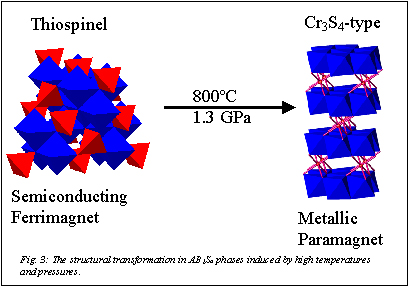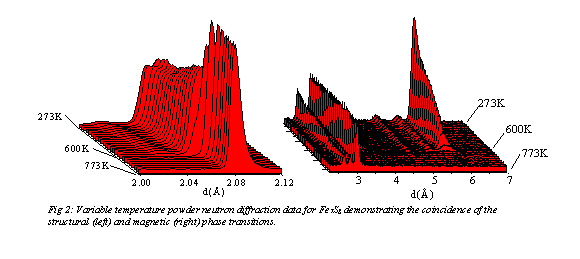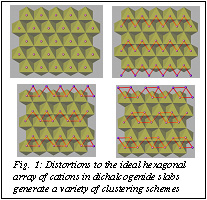Electronic and magnetic properties of transition-metal sulphides
Powell
Much of our research in this area is directed at materials containing two-dimensional structural units, such as the dichalcogenide slab of edge-sharing MX6 octahedra or MX5 square pyramids. Chemical substitution provides a means of manipulating the relative strengths of competing cation-cation interactions leading to compositionally-induced insulator to metal transitions.
We have shown that in ordered defect sulphides, containing octahedral MS2 slabs, these electronic transitions are related to distortions of the dichalcogenide block. Using a combination of X-ray and neutron diffraction we have identified a number of cation clustering schemes (Figure 1). The physical properties of ordered-defect sulphides also show a remarkable sensitivity to composition. In Cr2S3-d, anion deficiency at only the 3% level lowers the electrical resistance by six orders of magnitude. Anion-deficient materials exhibit a magnetoresistive response as high as 48% in the region of the magnetic ordering temperature, which compares favourably with the colossal magnetoresistance of thiospinels that have been the subject of worldwide activity.
We have progressed from these investigations to the study of sulphide minerals, many of which adopt ordered defect structures. We recently obtained the first conclusive proof that the magnetic ordering transition (TC = 600K) in the stoichiometric phase of pyrrhotite, Fe7S8, is accompanied by major structural reorganisation involving a change in stacking sequence of the sulphide layers (Figure 2).
Pressure-Induced Phase Transitions
An alternative approach that we have adopted for the preparation of materials in the region of the metal/non-metal divide is to use high pressure and temperature to effect structural phase transitions that have a dramatic effect on the electronic states. In-situ neutron diffraction established that the thiospinel CoCr2S4 transforms to a NiAs structure at 1.3GPa, 800ºC (Figure 3). Knowledge gained from the study of ordered defect phases enabled us to reduce dramatically the transformation pressure by nickel substitution. Remarkably, in Co1-xNixCr2S4, the structural transition leads to a change from ferrimagnetism to temperature-independent paramagnetism, indicative of major changes in the electron-electron interactions. This approach offers exciting possibilities for varying the strength and nature of interatomic interactions and generating compositionally identical phases with entirely different physical properties.


